Chapter 8
Structuring the Project
One of the most critical questions project sponsors need to address is whether a legally distinct “project financing entity” should be employed, and if so, how it should be organized. The appropriate legal structure for a project depends on a variety of business, legal, accounting, tax, and regulatory factors, including: (1) the number of participants and the business objectives of each; (2) the project's capital cost and the anticipated earnings pattern of the project; (3) the requirements of regulatory bodies; (4) the existing debt instruments and the tax positions of the participants; and (5) the political jurisdiction(s) in which the project will operate.1 This chapter analyzes these factors as they relate to the undivided joint interest, corporate, partnership, and limited liability company forms of organization. Figure 8.1 summarizes the principal considerations associated with selecting the appropriate form of organization for a project.
Figure 8.1 Comparison of Alternative Forms of Organization for a Project
a There are certain circumstances where alternative accounting models may be more appropriate. Their applicability depends on the particular facts and circumstances.
b Evaluating control can depend on the characteristics of the entity. There are two separate accounting models, the voting interest model and the variable interest model.
c If a partnership qualifies under Section 761 of the Internal Revenue Code and the regulations thereunder for exclusion from partnership tax treatment, the tax treatment of the partners will be the same as that of co-owners specified in the Undivided Joint Interest column. In order to qualify for the Section 761 election, the partners must (1) own the project assets as co-owners, (2) reserve the right separately to take their respective shares of any property produced or extracted, and (3) not jointly sell services or the property produced or extracted.
d An unaffiliated corporation can deduct 70 percent of the dividends it receives from the project corporation. The deduction percentage is 80 percent when the sponsoring corporation owns at least 20 percent but less than 80 percent of the project corporation. The deduction percentage is 100 percent when the sponsoring corporation owns at least 80 percent of the project corporation (because full tax consolidation is then possible).
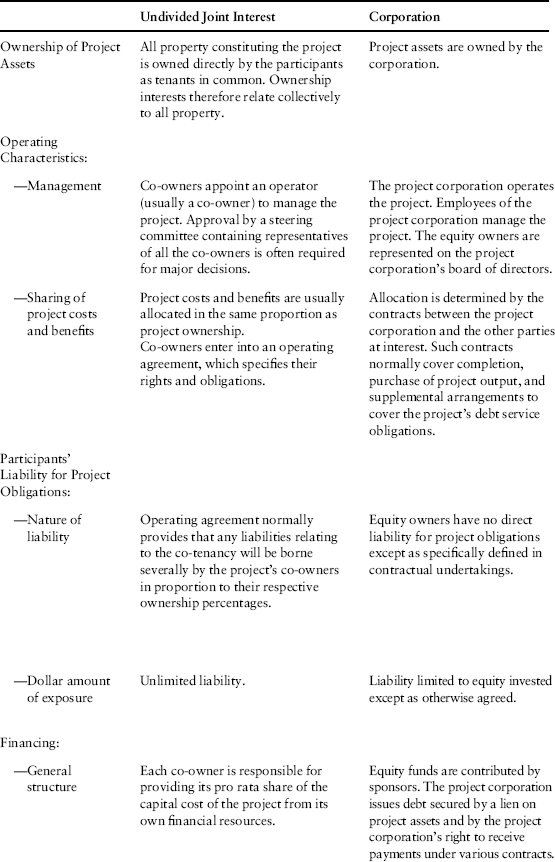
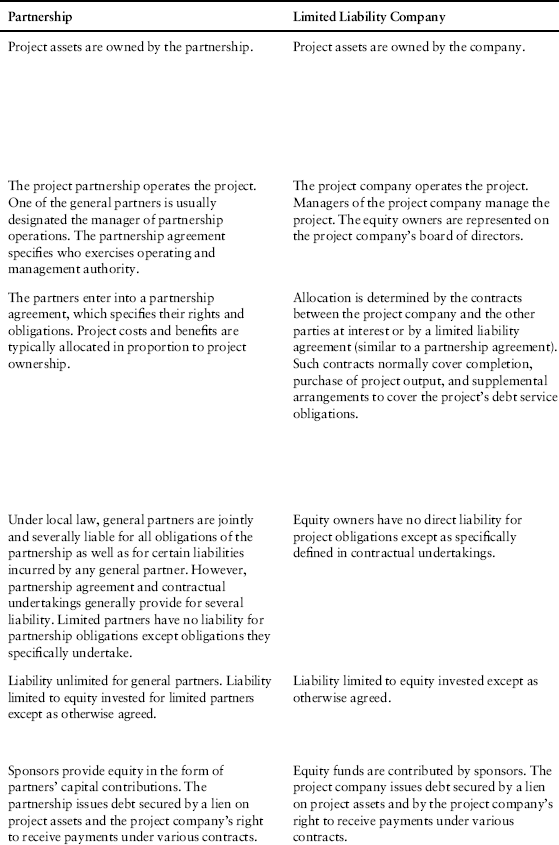
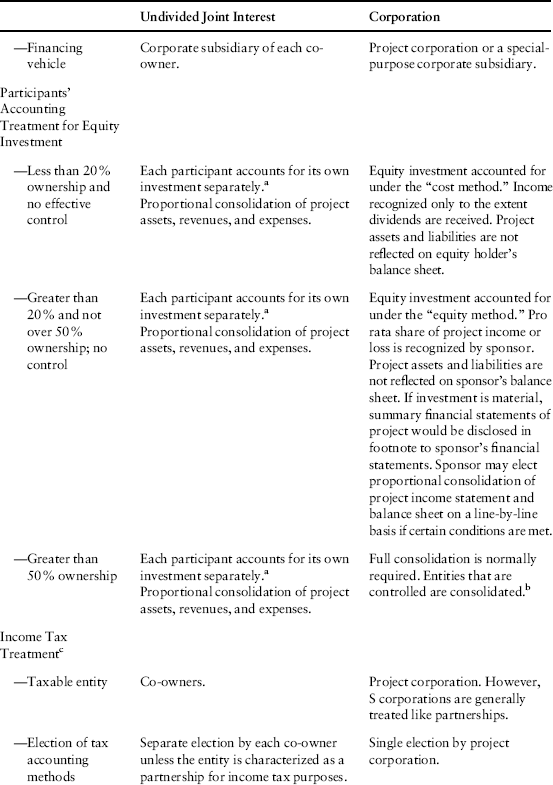
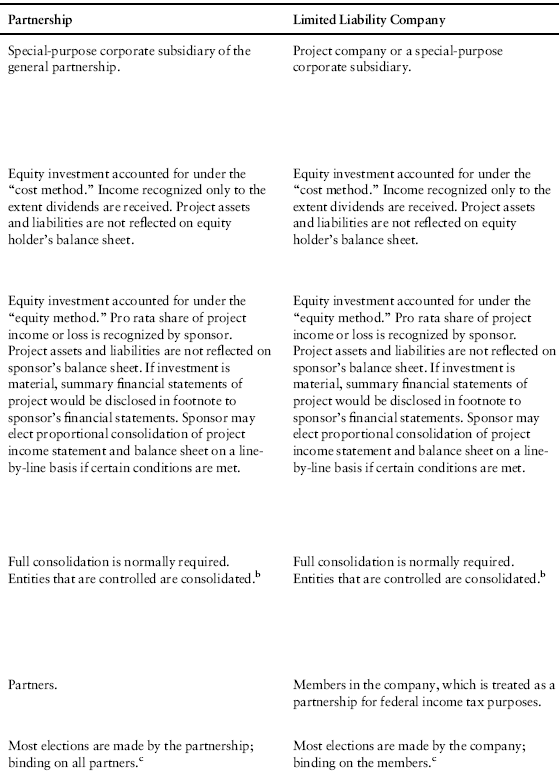
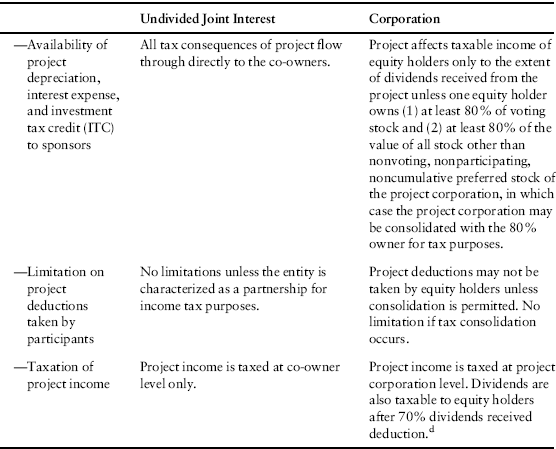
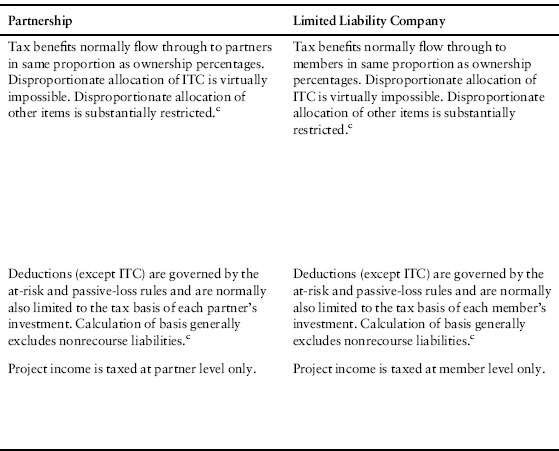
Undivided Joint Interest
Projects are often owned directly by the participants as tenants in common. Under the undivided joint interest ownership structure, each participant (1) owns an undivided interest in the real and personal property constituting the project and (2) shares in the benefits and risks of the project in direct proportion to the ownership percentage. The ownership interests relate to the entire assets of the project; no participant is entitled to any particular portion of the property.
When the project is organized, the participants choose someone in their ranks to serve as the project operator. This arrangement is particularly suitable when one of the owners already has operations in the same industry that are of a similar nature, or otherwise has qualified employees available. The duties of the operator and the obligations of all other parties are specified in an operating agreement. The agreement is an attempt to provide for all possible situations that might arise in the relationships among the various parties. The operator is responsible for maintaining a record of capital expenditures and operating expenses and for making the day-to-day operating decisions that determine the profitability of the project.
The operating agreement normally provides that the sponsors will bear the liabilities arising out of the project severally, in proportion to their respective ownership percentages. However, there is no dollar limit to the potential liability each sponsor may face. As a matter of law, the project sponsors are severally liable for all the obligations relating to the co-tenancy. But suppose that, for business or other reasons, they prefer not to accept a new co-owner who has acquired the interest of a defaulting sponsor. To avoid this situation, the remaining sponsors may elect to assume the obligations of the defaulting sponsor. In that case, the nature of each sponsor's liability is, in practical terms, joint and several rather than merely several. To lay off the attendant risks, the project sponsors normally purchase extensive commercial insurance covering general business liabilities.
In general, the joint venture agreement will require each participant to assume responsibility for raising its share of the project's external financing requirements. Each sponsor will be free to do so by whatever means are most appropriate to its circumstances. Thus, for example, if a sponsor owns 25 percent of the project, it will be required to provide, from its own resources, 25 percent of the funds necessary to construct the project. The project entity could not issue debt securities on its own because it does not have the legal standing to enter into a contract to repay the obligation.
There are often financing advantages to the undivided joint interest structure. The project sponsors are the financing entities. Each sponsor normally has established an earnings record and has an equity base and outstanding debt instruments. Accordingly, it has established banking relationships and experience in issuing new securities.
The undivided joint interest structure has particular appeal when firms of widely differing credit strength are sponsoring the project. By financing independently, the higher-rated credits can borrow at a cost that is lower than the cost at which the project entity can borrow, based on its composite credit. Depending on the sponsors' ability to take immediate advantage of the tax benefits of ownership arising out of the project, direct co-ownership may also provide the project sponsors with immediate cash flow to fund their equity investments. The tax benefits will reduce the sponsors' cash income tax liabilities and increase their net cash flow.
In certain situations, economic and financial considerations may suggest that it would be preferable to create a separate project entity that can arrange the financing for the project. If the project's construction cost is large relative to each sponsor's total capitalization, the project-related financing obligation of each sponsor, together with the normal financing requirements of its ongoing business, might exceed the debt limits imposed by its existing debt agreements. The additional debt load might cause the sponsors' debt-to-equity ratios and interest coverage ratios to suffer. Serious deterioration in these ratios might even result in lower bond ratings and therefore higher interest costs. The problem becomes more serious when there is a lengthy construction period during which the project has no earnings. It is also important to note that the ratio of indebtedness to capitalization required by the indentures of some going concerns is considerably lower than the initial debt ratios that lenders have typically permitted new projects to achieve.
Accounting Considerations
An undivided joint interest is not recognized as a separate entity for accounting purposes. Each participant reflects its proportionate share of project assets, revenues, and operating expenses in its own financial statements. Any direct liabilities incurred by a co-owner in order to fund its share of the project's construction cost would appear on its own balance sheet.
Tax Considerations
The Internal Revenue Service (IRS) has taken the position that the expense-sharing arrangement embodied in a manufacturing or processing facility that is organized as an undivided joint interest should be treated for tax purposes as a partnership.2 However, Section 761 of the Internal Revenue Code permits the sponsors to make an election to exclude the project from the rules pertaining to the taxation of partnerships. In general, the project sponsors can make a Section 761 election if they (1) own the property as co-owners, (2) reserve the right separately to take in kind or dispose of their respective shares of project output, and (3) do not jointly sell project output. Each project sponsor may delegate authority to sell its share of project output for a period of time, which cannot exceed one year. Exclusion from partnership tax treatment permits each sponsor to make its own tax elections as best suit its own tax situation. For example, the project sponsors would not all be required to use the same method to depreciate project assets. If the sponsors make a Section 761 election, the amount of tax deductions arising out of the project that a corporate co-owner can claim on its tax return becomes less restricted. But if the project is treated as a partnership for tax purposes, corporate partners, in some cases, will not be able to deduct amounts in excess of the tax basis in their respective partnership interests. (For a more complete discussion, see the Partnership section on tax considerations, later in this chapter.) Whether the undivided joint interest is taxed as a co-tenancy or as a partnership, project tax deductions arising from interest, depreciation, and investment tax credit, if any, flow through directly to the co-owners; “double taxation” of project income is avoided.
In some instances, the IRS has deemed an undivided joint interest to be an “association,” which is treated as a corporation for tax purposes. However, under the “check-the-box” regulations, such an organization ought to be treated as a partnership and not as a corporation.
Corporation
The form of organization most frequently chosen for a project is the corporation. A new corporation is formed to construct, own, and operate the project. This corporation, which is typically owned by the project sponsors, raises funds through the sponsors' equity contributions and through the sale of senior debt securities issued by the corporation. The senior debt securities typically take the form of either first mortgage bonds or debentures containing a negative pledge covenant that protects their senior status. The negative pledge prohibits the project corporation from granting a lien on project assets in favor of other lenders unless the debentures are secured ratably. The corporate form permits creation of other types of securities, such as junior debt (second mortgage, unsecured, or subordinated debt), preferred stock, or convertible securities.
The corporate form of organization offers the advantages of limited liability and an issuing vehicle. Nevertheless, the corporate form has disadvantages that must be considered. The sponsors usually do not receive immediate tax benefits from any investment tax credit (ITC) the project entity can claim or from construction period losses of the project (see “Tax Considerations” later on). Also, the ability of a sponsor to invest in the project corporation may be limited by provisions contained in the sponsor's bond indentures or loan agreements. In particular, the provisions restricting “investments” either by amount or by type may impose such limitations.
Accounting Considerations
Accounting Research Bulletin No. 51 (ARB 51) and Accounting Principles Board Opinion No. 18 (APB 18) embody the generally accepted accounting principles governing consolidation for financial reporting purposes. ARB 51 requires an entity that controls another entity to consolidate the controlled entity's financial results with its own on a line-by-line basis. Control normally means ownership of more than a 50 percent voting interest. However, control may also be exercised by other means, such as an agreement that vests control irrespective of the distribution of voting rights. APB 18 calls for equity accounting in noncontrol situations where there is a significant ownership interest.
The impact a project has on the financial statements of a project sponsor depends principally on the sponsor's percentage ownership of the project corporation. If a single sponsor owns more than 50 percent of project equity, full consolidation is generally required. In that case, the sponsor must consolidate the project's financial statements on a line-by-line basis and report a non-controlling interest in shareholders' equity to reflect the equity interest owned by others. The “equity method” is normally employed by project sponsors that have an equity ownership interest of between 20 and 50 percent. However, equity accounting is applied whenever significant influence is present. Under equity accounting, a sponsor carries its ownership interest in the project on its balance sheet as an investment, and reports its proportionate share of project income or loss. Project assets and liabilities in that case are not included on the sponsor's balance sheet. On the other hand, a sponsor may be able to consolidate its proportionate share of project financial statements on a line-by-line basis (“proportional consolidation”) if the project is in a line of business that is related to one of the sponsor's principal lines of business and certain other conditions are met. If a sponsor owns less than 20 percent of project equity, it will normally account for its investment under the “cost method”: The equity contribution is carried as an investment at original cost, and the sponsor reports income only to the extent it receives dividends from the project corporation. Project assets and liabilities are not included on the sponsor's balance sheet.
Regardless of the manner in which a sponsor accounts for its equity investment in the project, the sponsor would normally have to disclose in a footnote (1) any material contingent liability with respect to the project, and (2) summary financial statements for the project if the investment is material with respect to the sponsor's overall operations. The nature of the footnote disclosure for contingent liabilities depends principally on two factors: (1) the extent to which it can quantify the potential dollar amount of the liability and (2) the materiality of this amount in the context of the sponsor's overall operations. Figure 8.2 is an example of a footnote disclosure of contingent payment liabilities relating to pipeline transportation services.
Figure 8.2 Footnote Disclosure of Minimum Payment Obligation
Source: Panhandle Eastern Corporation, Annual Report, 1992, p. 47. (Trunkline Gas Company (Trunkline) is a wholly owned subsidiary of Panhandle Eastern Corporation.)
| Trunkline has contracts for transportation services which provide for minimum monthly charges determined by those companies' effective rates, as approved by FERC [the Federal Energy Regulatory Commission]. Trunkline's payments under such contracts in 1992, 1991, and 1990 were $13.6 million, $16.3 million, and $17.2 million, respectively. These amounts included payments to an affiliate in 1991 and 1990 of $5.3 million and $10.6 million, respectively. Minimum annual payments under the above agreements are $12.5 million for 1993, $11.6 million in 1994, $3.0 million in 1995, 1996, and 1997, and $1.3 million in 1998. |
Tax Considerations
A project corporation is a separate taxable entity. Section 1501 of the Internal Revenue Code permits an affiliated group of corporations to file a consolidated federal income tax return. Section 1504(a), as amended, permits a corporation to be included in an affiliated group only if other members of the group hold (1) 80 percent or more of the total voting power of the corporation's stock (common and preferred) and (2) 80 percent or more of the value of all classes of stock other than nonvoting, nonparticipating, noncumulative preferred stock. Assuming that no single participant owns sufficient equity to consolidate the project entity for tax purposes, the tax benefits of ownership arising out of the project, such as investment tax credit, depreciation deductions, and interest deductions, including deductions for interest paid during the construction period, are available only to the project corporation; they can be claimed only to the extent the project generates adequate taxable income once it starts operations. Such tax benefits would have to be deferred if the project corporation has operating losses. The tax benefits would be lost forever if carryforward periods are exceeded.
Under certain circumstances, a corporate structure with a capitalization that consists of disproportionate dollar amounts of voting and nonvoting securities can enable a project sponsor to realize the flow-through of the tax benefits of ownership, as happens with a partnership. For example, if the equity of the project corporation were comprised of $1,000 of nonvoting preferred stock and $10 of voting common stock, a sponsor who owns 80 percent of the voting stock would normally be able to consolidate the project entity for tax purposes. Tax consolidation would enable it to receive a direct flow-through of the project-related tax benefits of ownership.
Because the project corporation is a taxable entity, absent consolidation, the project's income is exposed to two levels of taxation. If the project corporation declares any dividends, the dividend income would be subject to income taxes at each sponsor's applicable income tax rate (which is reduced by the intercorporate dividends received deduction3). To this extent, “double taxation” of project earnings occurs.
Partnership
The partnership form of organization is frequently used in structuring joint venture projects. Each project sponsor, either directly or through a subsidiary, becomes a partner in a partnership that is formed to own and operate the project. The partnership issues securities (either directly or through a corporate borrowing vehicle) to finance construction. Under the terms of a partnership agreement, the partnership hires its own operating personnel and provides for a management structure and a decision-making process.
A partnership is particularly attractive for so-called “cost companies”; a profit is not realized at the project level but instead is earned further downstream in the sale of the project's output. The Internal Revenue Code generally precludes the utilization of a cost company in the corporate form of organization because, in the absence of consolidation, the tax benefits of ownership cannot flow through to any of the project sponsors.
The Uniform Partnership Act imposes joint and several liability on all the general partners for all obligations of the partnership. They are also jointly and severally liable for certain other project-related obligations any of the general partners incurs in the ordinary course of business or within the scope of a general partner's apparent authority. In theory, the extent of a general partner's potential liability could exceed its reported balance sheet liabilities if one of the general partners were to act improperly. A partnership can also have any number of limited partners. They are not exposed to unlimited liability. However, there must be at least one general partner who does have such exposure. The exposure of the project sponsors to project liabilities can be reduced in two ways. First, a wholly owned corporate subsidiary (called a “buffer subsidiary”) can be created to act as a general partner in the project. Figure 8.3 exhibits such a structure. However, there is necessarily some risk that a court might, in the future, “pierce the corporate veil” and impose liability on the parent unless the court is satisfied that the corporate subsidiary has a valid business purpose. Second, and more importantly, the partnership can provide in its loan agreements and other contracts that recourse under these contracts is limited to partnership assets.
Figure 8.3 Ownership Structure When a Project Is Organized as a Partnership
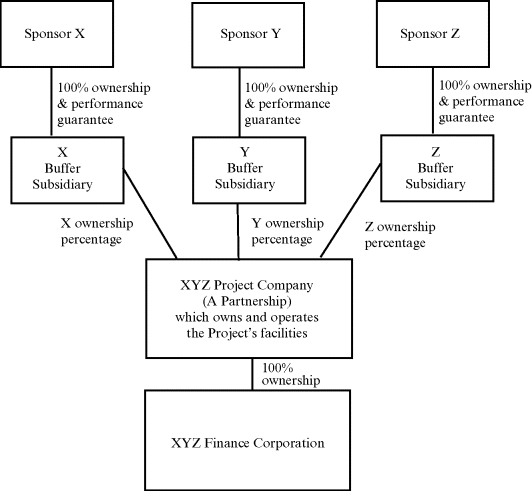
Each project sponsor must determine whether any provisions contained in its corporate charter would limit its ability to act as a general partner, and whether any bond indenture or loan agreement covenants exist that might prevent it from acting in that capacity. It must also check whether any of these debt agreements would include in the general partner's outstanding “indebtedness” for covenant compliance test purposes any portion of the partnership's debt. Similarly, indentures and loan agreements must be analyzed to determine whether any such restrictions would also apply to a buffer subsidiary, if one is used. Even if using a buffer subsidiary would avoid potentially troublesome charter or indenture restrictions, it might create other indenture problems. For example, indenture provisions governing permitted investments might prevent the use of a buffer subsidiary even in cases where they would not prevent a direct investment in the general partnership.
Corporate Financing Vehicle
A partnership typically borrows through a special-purpose corporate financing vehicle that is owned by the partnership. Legal investment regulations or investment policy considerations that limit certain major lenders' ability to purchase noncorporate obligations often necessitate the use of a corporate borrowing vehicle. In that borrowing structure, notes issued by the partnership would secure the debt obligations of the corporate borrowing vehicle. The terms of the partnership notes would be substantially identical to the terms of the notes issued by the corporate financing vehicle. The terms of the partnership notes would normally preclude recourse to the general credit of the partners. Accordingly, project lenders would have to look solely to the project cash flow for the payment of interest and for repayment of the principal on project debt.
Example
The Indiantown Cogeneration Project, which is the subject of Chapter 17, utilizes a corporate borrowing vehicle. The organizational structure is a limited partnership, Indiantown Cogeneration, L.P. The partnership set up Indiantown Cogeneration Funding Corporation to serve as a co-issuer of the debt incurred to finance construction of the project. The corporate vehicle has nominal assets and will not conduct any operations of its own; it was set up for the sole purpose of allowing certain institutional investors that might be limited as a matter of law or policy from investing in securities issued by partnerships to purchase first mortgage bonds issued by the partnership.4
Accounting Considerations
An equity interest in a partnership is generally accounted for by each partner in the same manner as an equity investment in a corporation, provided that recourse for partnership liabilities is limited to partnership assets. If a partner owns no more than 50 percent (but at least 20 percent) of partnership equity and does not exercise effective control, the partner would normally account for its equity investment under the equity method. Accordingly, the partner would recognize in its income statement its pro rata share of project income or loss. However, the partner would not reflect project assets and liabilities on its balance sheet. If a partner owns more than 50 percent of partnership equity, full consolidation is normally required. A general partner normally controls an entity and therefore normally would have to consolidate. However, other partners' rights could affect the assessment of control and therefore the need to consolidate.
A partner's contingent liabilities with respect to the partnership are accounted for in the same manner as discussed in connection with the corporate form. In addition, each partner is normally required to disclose summary financial statements of the partnership in a footnote to its own financial statements, if the partner's investment is material in relation to its overall financial condition.
Tax Considerations
A partnership is a separate entity for tax purposes. Unlike a corporation, the net income or loss of the partnership will be passed through to the partners. The partnership itself does not incur any federal income tax liability. Each partner includes in its own tax return its share of partnership income or loss based upon the partnership agreement, as long as it has substantial economic effect. Each partner benefits from investment tax credits, if any, arising from qualifying capital investment projects. The use of a buffer subsidiary to serve as one of the general partners does not impair the sponsor's ability to claim these tax deductions so long as the subsidiary is consolidated for income tax purposes. However, a partner may deduct partnership losses only to the extent of its tax basis in its investment in the partnership. A general partner's tax basis includes the sum of (1) its original investment in the partnership, (2) a pro rata share of partnership liabilities, and (3) a pro rata share of the partnership's undistributed income reduced by a pro rata share of the partnership's losses and distributions to the general partner.5 A limited partner's tax basis in his partnership interest is determined in the same manner as a general partner's, except that it excludes partnership liabilities for which only the general partners are liable. Partners' losses are also limited by the at-risk and passive-loss rules. The Internal Revenue Code provides that most elections affecting the partners' taxable income must be made at the partnership level, in which case they generally apply uniformly to all partners.
As in the case of an undivided joint interest, the partners to a project can make a Section 761 election in order to avoid partnership tax treatment, even though the project is legally constituted as a partnership. Such an election permits each partner to account for its investment in the project by utilizing, for tax purposes, the method most appropriate to its own tax situation. It also enables a partner to deduct its share of losses from the partnership in excess of its tax basis in its partnership investment. However, the Section 761 election is only available if the partners (1) own the project assets as co-owners and (2) reserve the right to take their separate shares of any output that is produced or extracted. This election will generally not be available if the project is structured as a partnership under applicable partnership law (see the discussion of tax considerations for an undivided joint interest, earlier in this chapter).
Under the “check-the-box” regulations, domestic partnerships will be characterized as partnerships, and not as corporations, for federal income tax purposes, unless an election is made to the contrary.
Project financing is part of a trend toward increasing direct investment in natural resources and capital equipment. Under the Internal Revenue Code, the traditional corporate form of organization is usually not the most tax-efficient form of organization for such activities. The partnership form is more advantageous from a tax standpoint.
Master Limited Partnerships
Publicly traded limited partnerships, often referred to as master limited partnerships (MLPs), became popular in the United States in the 1980s. MLPs were free of double taxation, just like any other partnership, but could be publicly traded. Partnership units were listed on a major stock exchange, just like shares of common stock of a corporation. The Revenue Act of 1987 eliminated the tax advantage of most MLPs by requiring that they be taxed as corporations. However, there is an important exception. MLPs engaged in the natural resource extraction and oil and gas pipeline industries, and some other kinds of partnerships with essentially passive income, are still taxed as partnerships.6 The master limited partnership vehicle should be considered as an alternative to the corporate form when the project sponsors hope to have the project company's equity interests publicly traded eventually (e.g., after several years of successful operation) and the project involves the exploration, development, production, processing, refining, transportation (including an oil or gas pipeline), or marketing of any mineral or natural resource (including timber or geothermal energy).7
Limited Liability Company
Every state in the United States has enacted a statute authorizing limited liability companies. A limited liability company is treated as a corporation for legal liability purposes. In 1988, the Internal Revenue Service ruled that a Wyoming limited liability company should be treated as a partnership for federal income tax purposes. A project company wishing to organize as a limited liability company must comply with the particular limited liability company requirements under the laws of the state in which the company will be organized. Under the “check-the-box” regulations, the entity will be characterized as a partnership, and not as a corporation, for federal income tax purposes, if it has more than one member unless an election is made to the contrary.
A limited liability company is a distinct legal entity. It has three advantages relative to alternative forms of organization:
A limited liability company can be organized in any state. However, some states do not recognize the limitation on liability for a limited liability company formed in another state. The limited liability company form of organization may be suitable for a joint venture when the co-sponsors desire limited liability and want the ability to claim tax losses during the construction period, but none of them wants to serve as the general partner of a limited partnership.
The Cogeneration Project
Engineering Firm and Local Utility, the two active equity investors in the Cogeneration Project, immediately dismissed the undivided joint interest structure from consideration. Neither company wanted project-related debt on its balance sheet. They agreed that a separate legal entity would be established to construct and own the cogeneration facility.
Engineering Firm and Local Utility wanted to shield themselves from project liability, which the corporate form of organization would achieve. However, neither company would be able to consolidate the project company because neither one would own an 80 percent voting interest. The corporate form of organization would bottle up the losses for tax purposes during the planned 24-month construction period and the early years of operations (because of the accelerated depreciation provisions of the Internal Revenue Code and the large interest deductions).
The partnership form of organization would flow through the losses for tax purposes. However, both Engineering Firm and Local Utility wanted the flexibility to market equity interests in the project entity to outside investors. Passive equity investors do not want to be general partners because a general partner is exposed to operating risks and other noncredit risks. They therefore decided to employ a limited partnership structure by forming a special-purpose corporation to serve as the general partner. Figure 8.4 illustrates the ownership structure selected for the Cogeneration Project.
Figure 8.4 Ownership Structure for the Cogeneration Project

Conclusion
The choice of legal structure can have important tax implications. It can also affect the availability of funds to a project and the cost of raising project financing. Project financing requires that the economic rewards be allocated in a manner commensurate with the project risks. The choice of a project's legal structure affects both allocations. Project sponsors need to work closely with the project's financial and legal advisers to evaluate alternative legal structures and determine the structure that is most advantageous.